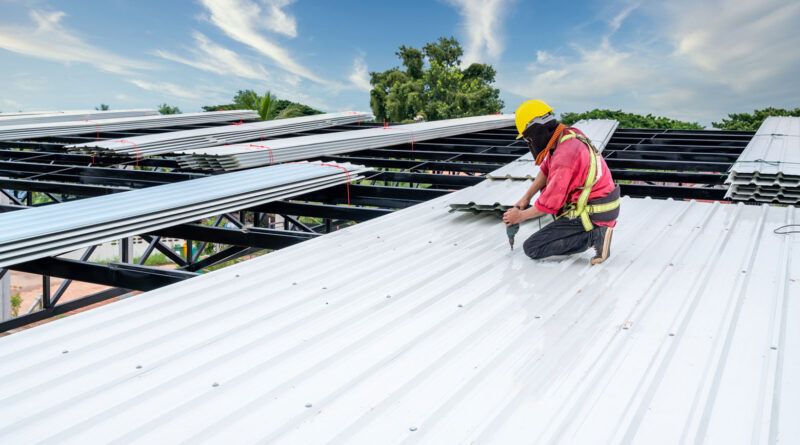7 Signs It’s Time to Call a Roofer
Your roof is one of the most critical components of your home. It protects you and your belongings from the elements. Like any part of your house, it requires regular maintenance and occasional repairs to ensure it remains in optimal condition. Recognizing signs of roof damage early can prevent more extensive and costly issues down the line. Here are seven common signs that indicate it’s time to call a professional roofer. From missing shingles to water stains on your ceiling, knowing when to seek expert assistance can help prolong the lifespan of your roof and maintain the integrity of your home’s structure.
1. Missing or Damaged Shingles
Missing or damaged shingles are a clear indication of roof damage and should be addressed promptly. Strong winds, heavy rainfall, and aging can cause shingles to become loose, cracked, or completely blown off. When shingles are missing or damaged, it exposes the underlying layers of the roof to moisture, which can lead to leaks and water damage inside your home. A professional who provides roofing services in your area can help. For instance, consider searching for Houston roofing services if you are in the Houston area. They can assess the extent of the damage and recommend the appropriate repairs or replacements to restore the integrity of your roof. Ignoring missing or damaged shingles can lead to more significant issues over time. Moisture can seep into the underlying roof structure, causing rot, mold growth, and structural damage. Address these issues promptly to prevent further deterioration and more costly repairs in the future.
2. Leaks or Water Stains
Leaks or water stains inside your home are telltale signs of roof issues that require immediate attention. Water infiltration can cause significant damage to your ceilings, walls, insulation, and even electrical systems if left unchecked. Look out for damp spots, water stains, or peeling paint on your ceilings or walls, especially after heavy rainfall. Check your attic for signs of water penetration, such as wet insulation or mold growth. Calling a roofer at the first sign of a leak can help prevent further damage and costly repairs. Water damage can compromise the structural integrity of your home and pose health risks due to mold growth. Promptly address leaks or water stains to mitigate these risks and ensure the safety and comfort of your household.
3. Sagging Roof
A sagging roof is a serious structural issue that warrants immediate professional intervention. It may indicate problems with the roof’s underlying support structure, such as damaged rafters or deteriorating decking. A sagging roof can compromise the integrity of your entire home and pose safety risks to you and your family. If you notice any noticeable dips or sags in your roofline, contact a roofer right away to assess the situation and recommend appropriate repairs or reinforcements. A sagging roof can lead to further structural damage if left unaddressed. It can put additional strain on the walls and foundation of your home, leading to costly repairs and safety hazards. Timely intervention by a professional roofer can help prevent these issues and ensure the stability of your home’s structure.
4. Granules in Gutters
Finding granules in your gutters is a common sign of roof deterioration, especially for asphalt shingle roofs. Over time, the protective granules on shingles can wear off due to weathering, age, or poor installation. When granules start to accumulate in your gutters, it indicates that your shingles are nearing the end of their lifespan and may need to be replaced soon. Ignoring this sign can lead to accelerated shingle deterioration and potential roof leaks. A professional roofer can inspect your roof and advise you on the best course of action to maintain its longevity and performance. Granule loss can compromise the effectiveness of your shingles in protecting your home from the elements. Without adequate granules, shingles become more susceptible to damage from UV rays, moisture, and debris. Addressing granule loss promptly can help extend the lifespan of your roof and prevent costly repairs.
5. Damaged Flashing
Flashing is a thin metal strip installed around roof penetrations such as chimneys, vents, and skylights to prevent water infiltration. When flashing becomes damaged or deteriorated, it can compromise the integrity of your roof and lead to leaks. Look for signs of rust, corrosion, or gaps in the flashing around these areas. Check for loose or missing flashing that may have been dislodged by wind or other elements. If you notice any issues with your flashing, contact a roofer to inspect and repair or replace it as needed to prevent water damage. Damaged flashing can exacerbate existing roof issues and lead to more extensive water damage if not addressed promptly. Flashing provides a crucial barrier against water infiltration at vulnerable points in your roof, and compromised flashing can compromise your entire roofing system. Timely repairs by a professional roofer can help ensure your roof’s long-term integrity and performance.
6. Algae or Moss Growth
Algae or moss growth on your roof can detract from its appearance and indicate underlying moisture issues. These organisms thrive in damp, shaded areas and can compromise the integrity of your shingles over time. While algae and moss growth may not directly cause roof leaks, they can trap moisture and accelerate shingle deterioration. Regularly inspect your roof for signs of algae or moss growth, especially in areas with poor sunlight exposure. A professional roofer can assess the extent of the growth and recommend appropriate treatments to remove it and prevent future recurrence. Algae and moss growth can compromise the aesthetic appeal of your home and decrease its resale value. Addressing this issue promptly can help maintain your home’s curb appeal and protect your investment. Treating algae or moss growth can help extend the lifespan of your roof and prevent costly repairs.
7. Aging Roof
As your roof ages, it becomes more susceptible to wear and tear, requiring regular maintenance and eventual replacement. Most asphalt shingle roofs have a lifespan of 20-30 years, while other roofing materials may last longer or shorter depending on various factors. If your roof is nearing the end of its expected lifespan, assess its condition and plan for replacement if necessary. Signs of aging include curling or buckling shingles, loss of granules, and increased frequency of repairs. Consulting a roofer can help you determine the best course of action to ensure the longevity and performance of your roof for years to come. An aging roof can compromise the energy efficiency and structural integrity of your home. By replacing your roof before it fails, you can avoid costly repairs and ensure the comfort and safety of your household.
Your roof plays a crucial role in protecting your home and should be maintained regularly to ensure its longevity and performance. By recognizing the signs of roof damage early and calling a professional roofer when necessary, you can prevent more extensive issues and costly repairs down the line. From missing or damaged shingles to leaks, sagging, and aging, these signs indicate potential problems that require expert attention. Schedule regular roof inspections and maintenance to catch issues before they escalate. Investing in your roof’s upkeep now can save you time, money, and stress in the long run.




